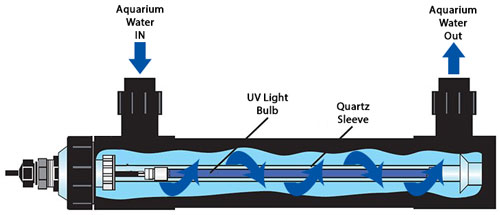I see many pond owners have UV (Ultra-Violet) Sterilizers on their ponds to help battle nuisance algae caused by the sunlight, but why would they be of any use on a saltwater aquarium? We don’t have tanks being bombarded with sunlight!
The fact is there has been and probably always will be the great debate in our hobby as to whether a UV Sterilizer is needed or even beneficial in fish tanks.
Aquarium Ultra-Violet (UV) Sterilizers use UV-C light to irradiate & kill single-celled organisms that can cause disease, illness, and nuisance algae in an aquarium. Fed from a pump, they work best with 3x-5x the aquarium volume flowing through them each hour.
To help you follow and understand how UV Sterilizers work you can check out a huge selection of UV systems for all aquarium sizes Here at Amazon.com
With this article, I wanted to dive deep into both sides of the arguments, look at the science behind them and help you decide if a UV Sterilizer is a good addition to your system.
What Is An Aquarium UV Sterilizer?
In simple ‘Layman’s Terms,’ a UV Sterilizer is a unit which houses a long Ultra-Violet light bulb. Clean and filtered water from the aquarium is passed along this bulb at a recommended flow rate to allow the bulb to irradiate and kill the waterborne organisms that pass next to it. The water then exits the unit to be returned to the aquarium.
The UV light attacks the single-celled organisms at a DNA level and either alters them or breaks their links causing mutations or in other words, it gives the cells Cancer. What this does is prevent the cells from reproducing.
Over time the cell population of the parasites, nuisance bacteria or algae will diminish which will help to give you a healthier, less time-consuming aquarium while keeping the risk of fish disease and illness to a minimum. Another bonus is that you will get crystal clear water!
What Is An Aquarium UV Sterilizer Used For?
The aquarium UV Sterilizer is actually designed to do two jobs:
- Polishing the water to provide you with optimum clarity
- Sterilize any algae, parasitic or nuisance bacteria organisms that are suspended within the water
Let’s look at each of these in more detail:
Water Polishing
Having water that is crystal clear is the dream for many aquarists. When you walk into a room and see a pristine aquarium with vibrant corals and a rainbow of color swimming around it will instantly grab ANYONE’s attention! Providing a way to polish the water adds to this viewing experience and that is why we have a reef aquarium in the first place.
Think of all the cars at a car show – They are all spotless and gleaming in the lights or sun, why? To enhance the viewing pleasure of the people looking at them. Your reef is no exception.
The UV Sterilizer polishes your water by attacking the algae-based cells suspended in the water. By not allowing the algae-cells to reproduce, the green tinge of the water is removed because the cells die and are removed by the protein skimmer or consumed by the beneficial bacteria in your tank.
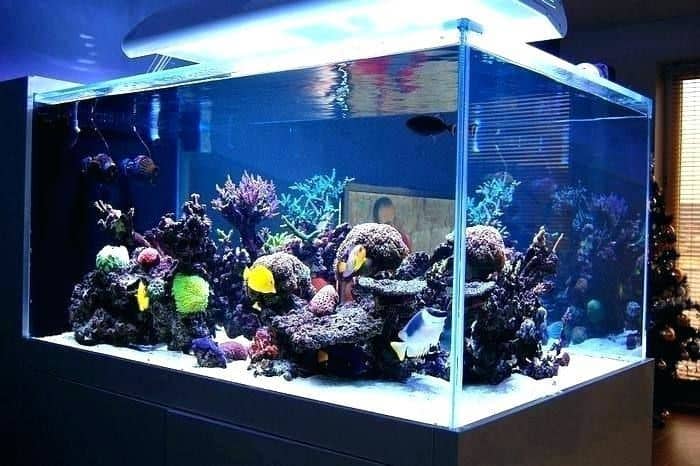
Used in conjunction with a good Activated Carbon your water will have a clarity that will even surprise yourself! It can surprise even the most skeptical owner who installs a UV sterilizer!
Water Sterilizing
This is the most well-known aspect of a UV Sterilizer. Sterilizing your water to help with disease, but this is only part of the job they do.
As the organisms pass by the UV bulb they become irradiated and mutate. The UV Sterilizer does not instantly kill the cell but changes it so that it will not replicate and then with time it will die. This time period can vary.
By doing this, the UV sterilizer will gradually reduce the problematic single-celled organisms in your water that can create havoc in your aquarium. The organisms that UV light is great for attacking are:
- The cells of the two most common illnesses, Ich and Velvet when suspended in the water column
- Bacteria-based infections that can affect fish or coral health – Cyanobacteria is a good example. It can smother corals and also consume large amounts of oxygen within your water
- Plant-based cells that can bloom when nutrients are high giving you nuisance algae problems that can be hard to battle
The UV Sterilizer is more of a preventative measure which can help to prevent or reduce the severity of the above organisms which could cause a potentially serious issue in your aquarium
Facts & Myths About Aquarium UV Sterilizers
Fact
- Not all UV Sterilizers are the same! Ultra-Violet Sterilization only occurs in the ‘Germicidal’ light wavelength of 240 to 280 nanometers. Some of the cheaper UV units may not have the light in this wavelength. Outside of these wavelengths, they may polish the water, but they will not sterilize it
- There are different categories of UV light and the cheaper units may be of the wrong category for Germicidal sterilization. UV-C is the wavelength used for the best Aquarium Sterilizers
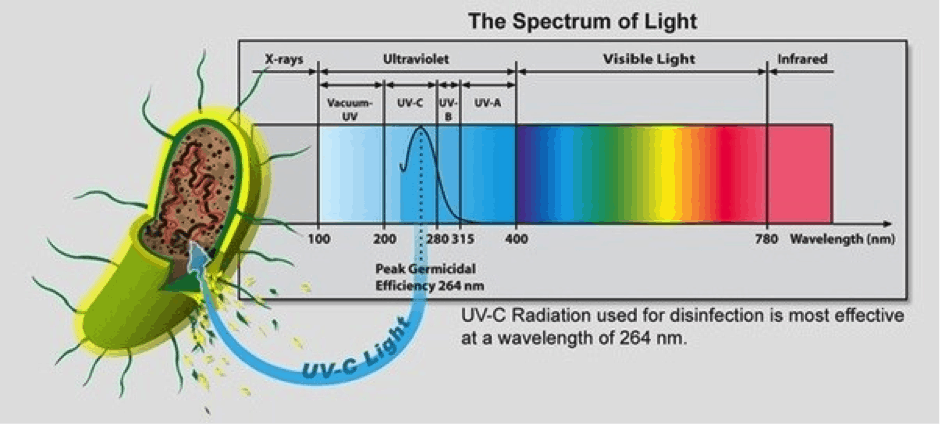
- You need to match the flow rate through the unit to the manufacturer’s recommendations. Too fast a flow will not allow enough ‘Contact Time’ for the UV light to irradiate the cell. Too slow and you are not passing enough water through the unit, therefore, it will be inefficient.
- UV Sterilizers can help prevent future outbreaks of parasites and diseases. If you have just battled and hopefully overcome a disease like Ich, installing a UV sterilizer will help to keep any of the remaining bacteria or parasitic organisms from multiplying and waiting for their next victim. By irradiating the cells and preventing them from reproducing it is reducing the numbers of cells available to take hold and infect a host again.
- UV Sterilizers are very good at reducing water-borne algae blooms – sometimes referred to as ‘Pea Soup’ water. By irradiated and killing off the plant-based cells they will gradually clear the water over time and help prevent future outbreaks.
Myth
- UV Sterilizers kill your beneficial bacteria – UV Sterilizers only irradiate the cells that are suspended in the water and pass through the unit. The Nitrosomonas and Nitrobacter bacteria that make up the base of your nitrifying bacteria are all surface-based organisms. This means they are not found floating in the water once they are established. They will be living on your rock, substrate, and surfaces in your entire system. Yes, any that become water-borne and pass through the unit will be killed, but this amount is insignificant
- I need to oversize my UV unit like a protein skimmer – No, the manufacturer will recommend the appropriate size for your Water Volume, not tank size. If you have a tank, sump, refugium and frag tank, all that water volume needs to be added together to establish your system volume. This system volume is what you size the UV unit too
- A UV Sterilizer can cure Ich & Velvet – A UV sterilizer cannot cure the disease as it has already taken hold on the fish and it is not water-borne. What a UV Sterilizer can do is prevent any transfer of a disease through the water from fish to fish. It will also help reduce the number of disease spores in the water, which in turn reduces the chances of a disease maturing
- I don’t need to do as much maintenance now – A UV Sterilizer can only work efficiently when the UV rays can penetrate the cell. If the water is dirty or cloudy this minimizes the number of light rays that reach the nuisance cells
How Do You Size An Aquarium UV Sterilizer?
Saltwater aquariums require 3-5x the system volume ran through the UV Sterilizer every hour.
eg:
30 Gallon Aquarium = 90-150gph
50 Gallon Aquarium = 150-450gph
75 Gallon Aquarium = 225-375gph
100 Gallon Aquarium = 300-500gph
The performance of your UV sterilizer depends on the dwell time of the microorganisms against the light. The dwell-time is defined by:
- The flow rate of the pump that forces water past the UV light bulb
- The length of the UV bulb
- The Wattage power of the UV bulb
The Ultra-Violet dosage your water will receive is a measure of Light Intensity x Exposure Time. UV Dosage is measured in μW/sec².
The dosage for saltwater aquariums varies depending on which organisms you are trying to kill and which you are trying to protect:
A dosage of 75,000-90,000 μW/sec² is best suited for saltwater fish-only aquariums. This high dosage is most effective at killing parasites associated with fish illness and disease, but at this high dosage, it will also kill the plankton-based organisms that are free-floating in the water.
A dosage of 30,000-45,000 μW/sec² is best suited for saltwater reef aquariums. This dosage is low enough to not kill any plankton-based organisms that are free-floating in the water which the coral and invertebrates feed off, but is enough to attack the parasitic and disease-based organisms that can cause fish illness.
More information on Fatal Organism Dosages:
| Targeted Organism | Lethal UV Dosage – μW/sec² |
| Viruses | 15,000 |
| Bacteria | 15,000 – 30,000 |
| Fungi | 22,000 – 30,000 |
| Protozoa | 90,000 |
Here is a great chart from Aqua Ultraviolet showing the dosages and flowrates for specific aquarium sizes:
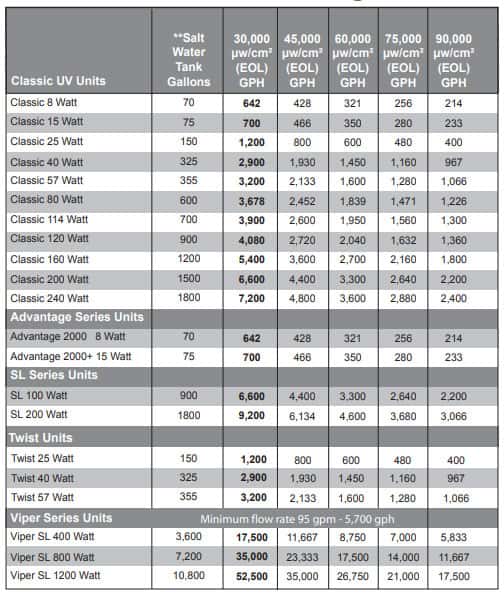
Like every product category in this hobby, there are dozens of different brands, sizes, models and types of UV Sterilizer, so which one is right for you. The trick is to run through this process to help you decide:
STEP 1 – Work Out Aquarium System Volume
You need to work out the total system volume of your aquarium system.
Example #1:
You run a RedSea Reefer Rimless 65 Gallon AIO (All-In-One) Aquarium
Your total volume is going to be around 65 gallons.
Example #2:
You run a Marineland Corner-Flo 150 Gallon Aquarium
You run a Trigger Systems Sapphire CR44 43 Gallon Sump
You plan to install a Mr Aqua 22 Gallon Frag Tank
Your total volume is going to be around 150+42+20 =212 gallons.
STEP 2 – Installation Space Available
How much space do you have to install the unit? Do you have an AIO aquarium and you need a HOB (Hang-On-Back) sterilizer or do you need to place the UV Sterilizer in the stand with a pump that pulls water out of the AIO filter section and runs it to the UV unit and back to the aquarium?
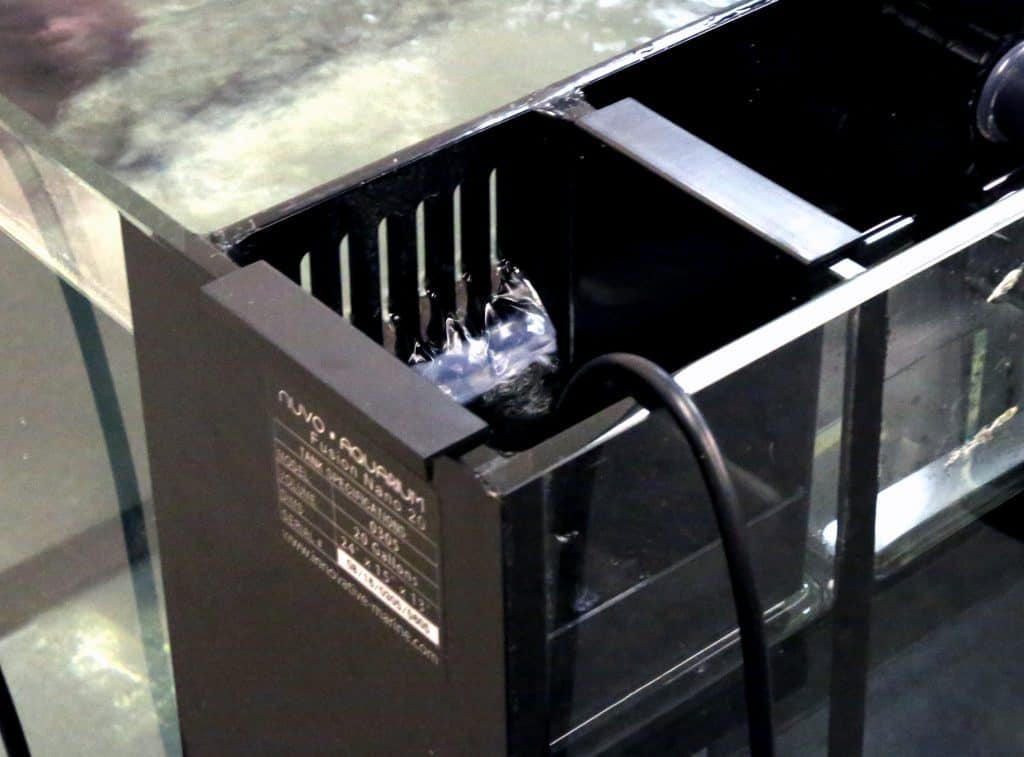
Do you have lots of room by your sump and can run the UV unit off a manifold outlet?
The installation or mounting locations will dictate on the type and physical size of UV sterilizer you can get.
You also need to think about room to access the unit for maintenance. Can you slide the bulb out of the unit with having to disconnect the unit from its installation location?
STEP 3 – Selecting The Brand
Do you have a favorite brand of aquarium manufacturer? Does your aquarium manufacturer make a UV Sterilizer purposely to fit in your filter housing?
Is the UV you want stocked by one of the major online stores? If not, why? Do you want to run the risk of buying a cheap ‘No-Name’ sterilizer for it to not work? Money is always at the forefront of most aquarists’ minds, but is it better to save and get a better brand or run the gauntlet on a cheap ‘Knock-Off’?
STEP 4 – Select The Sterilizer
UV Sterilizer selection. I’m going to give a couple of example options so you can see how your process might work. We will use the two examples from above:
Example #1:
Waterbox Rimless 65 Gallon AIO (All-In-One) Aquarium
Manufacturer Designed UV for the Rimless 65 = NO
(Find this tank Setup Guide Here)
Hang-On-Back Option:
Aqua UV Advantage 2000 15W HOB UV Sterilizer
75 Gallons Here at Amazon.com
Find User Manual HERE
Recommended Flow for Reef = 400-700GPH
Dosage = 30,000-45,000 μW/sec²
Recommended Pump:
Sicce Syncra Silent 2.0 568GPH – Here at Amazon.com
Recommended Flow for Fish Only = 235-280GPH
Dosage = 75,000-90,000 μW/sec²
Recommended Pump:
Sicce Syncra Silent 1.0 251GPH – Here at Amazon.com
Total Cost For This Setup:
Reef = $213.00
Fish Only = $176.00
Wall Mounted Option:
Aqua UV Classic 15W UV Sterilizer
75 Gallons $300 at Amazon.com
Find User Manual HERE
Recommended Flow for Reef = 400-700GPH
Recommended Pump:
Sicce Syncra Silent 2.0 568GPH – Here at Amazon.com
Recommended Flow for Fish Only = 235-280GPH
Dosage = 75,000-90,000 μW/sec²
Recommended Pump:
Sicce Syncra Silent 1.0 251GPH – Here at Amazon.com
Total Cost For This Setup:
Reef = $382.00
Fish Only = $345.00
Example #2:
Coralife Biocube BC32 AIO (All-In-One) Aquarium
Manufacturer Designed UV for the BC32 = YES
(Find this tank Setup Guide Here)
In-Tank Mounted Option:
Coralife BioCube 5W UV Sterilizer
35 Gallons Here at Amazon.com
No pump is required as this connects between the existing return pump and filer bay outlet nozzle!
Total Cost For This Setup:
Reef = $57.00
Fish Only = $57.00
Should Aquarium UV Sterilizers Run All The Time?
This is another debate within the industry! Some people run them 24/7, some people only run them for a few hours each day to save bulb life.
I have hunted high and low to try and find any scientific data to prove that running the sterilizer for only a few hours a day is as beneficial as running it 24/7, alas I have turned up nothing.
The only recommendation I can give is to follow the manufacturer’s directions. Every one of the manufacturers I have looked at recommends running your sterilizer all the time. To me, this is a good enough reason to keep it on.
The only time it is not beneficial to run a UV Sterilizer is during the initial aquarium cycle. This is due to the bacteria not being established on the surfaces within your system. Some may become water-borne which will then be killed if they go through the sterilizer and at that point in time you need the bacteria to be growing rapidly, not begin eradicated.
How Do You Install An Aquarium UV Sterilizer?
Here are some best practices when looking for a location to install your UV Sterilizer:
- The UV Sterilizer works best when the water is a clean as possible. because of this, it is best to ensure the input hose to the UV is fed after your filtration. Usually just before the water is to be returned to the aquarium is the best place to install the unit
- If it is a HOB type be careful of how the water enters back into the tank from the Sterilizer. Splashing will cause salt creep buildup which not only looks unsightly but could build up enough to redirect the flow of water outside the return slipway and flood your floor
- Always be sure you have a drip loop to ensure any leaking water does not run down the cable to the plug. This could cause a shock and fire hazard
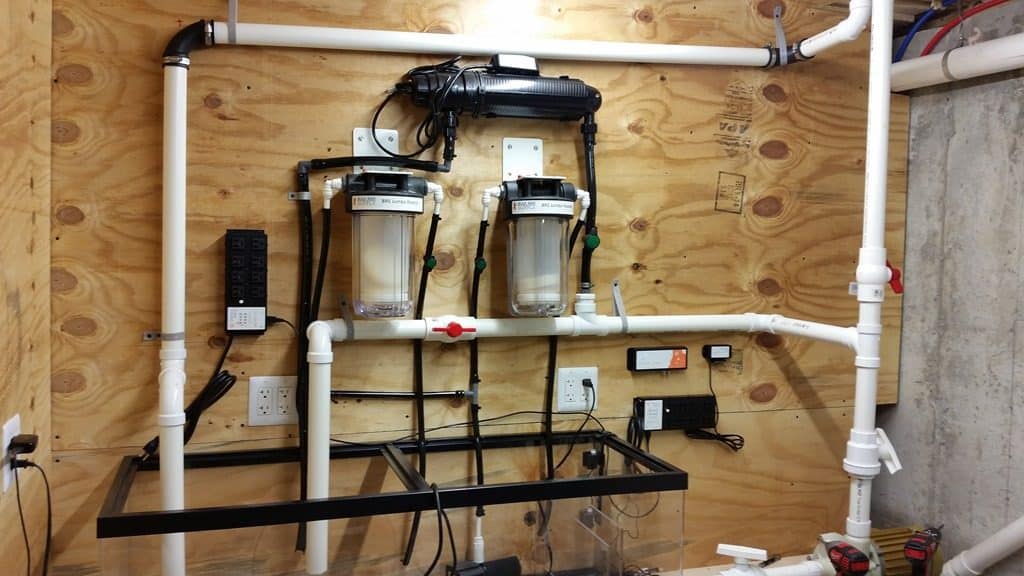
- Install in a location to allow for easy maintenance. Most Sterilizers allow the bulb to be slid outwards. Ensure you have enough room to slide the bulb and quartz sleeve (if installed) fully from the unit without having to remove the unit from its mounting
- Observe the correct flow direction. Some units may have an arrow to indicate the direction of the water flow. Some units may be labeled with ‘IN’ & ‘OUT’. Follow the manufacturer’s directions
- Be sure to observe if your particular unit can be installed vertical or horizontal. Some units may be limited to a certain orientation
- Ensure you have easy access to the feed pump for easy maintenance
- DO NOT use any form of metal pipe clamps! I find two zip ties around the pipe on each hose barb works perfectly
- If your sterilizer has an external power transformer, mount it up out of the away of splashes. Do not leave it on the floor in case of a leak
- UV Sterilizers work best when the bulb temperature is around 100°F. Too cold or too hot and the efficiency of the bulb is reduced. Keep this in mind when looking for a mounting location
How Do You Maintain An Aquarium UV Sterilizer?
Each manufacturer has a recommended bulb life for their units. By procrastinating and not changing the bulb when recommended, you will just have an expensive light that does nothing.
Recommended Bulb Life:
| UV Sterilizer | Bulb Life | Bulb Cost |
| Aqua Ultraviolet Classic | 14 Months | From $51.00 |
| Aqua Ultraviolet Advantage 2000 | 14 Months | From $42.00 |
| Coralife Turbo Twist | 11 Months | From $51.00 |
| Innovative Marine AquaShield | 9-12 Months | From $19.99 |
| Pentair Aquatics Smart UV | 12 Months | From $59.99 |
- Along with changing the bulb at the recommended intervals, it is probably a good idea to replace the small O- ring that keeps the cap sealed. When ordering a replacement bulb just add on the o-ring for a few bucks more
- Always ensure you turn off the power to the UV before doing any maintenance on the unit. The UV rays could harm you if you are exposed to them for any period of time
- Do not handle the bulb or quartz sleeve with bare hands. Your natural oils will shorten the bulb life. Use Denatured alcohol and a soft cloth to clean the lamp
Cleaning the quartz sleeve must be done with care, it is fragile. CLR or other similar cleaning products can be used but must be thoroughly rinsed before reinstallation - Be careful when screwing the endcaps back on to not overtighten and crack the quartz sleeve. Snug is good!
To Finish
A good quality UV Sterilizer is a great investment in the prevention of illness and disease provided the Sterilizer is of a large enough wattage with the recommended flow rate through it.
The added benefit of polishing the water to give a pristine clarity in my mind is worth the cost for that reason alone!
With a regular maintenance routine, a solid quarantine procedure, coral dipping and a UV sterilizer you can be sure you will have some of the healthiest livestock around. We are here to provide the best life possible for our aquatic friends and these steps are a good way towards this.
Further Reading
Some more articles to help you with your learning journey!

